engine Alfa Romeo 4C 2015 Owner handbook (in English)
[x] Cancel search | Manufacturer: ALFA ROMEO, Model Year: 2015, Model line: 4C, Model: Alfa Romeo 4C 2015Pages: 199, PDF Size: 7.67 MB
Page 139 of 199

ENGINE COMPARTMENT FUSE BOX
fig. 112
DEVICE PROTECTED FUSE AMPERE
Headlight beam switch (for versions/markets, where provided) F09 5
Single tone hornF10 10
12 V socket / cigar lighter F86 15
External mirror defrosters F88 7.5
.
DASHBOARD FUSE BOX
fig. 114
DEVICE PROTECTED FUSE AMPERE
Central lockingF38 15
Two-way windscreen washer pump F43 20
+30 Driver side electric windows F47 20
+30 Passenger side electric windows F48 20
135
Page 142 of 199

WARNING
115) Before towing, turn the ignition
key to MAR-ON and then to STOP
without removing it. The steering
column will automatically lock
when the key is removed and the
wheels cannot be steered. Also
check that the gearbox/
transmission is in neutral (N).
116) When towing, remember that
the assistance of the brake servo
is absent. Consequently, more
force is required at the pedal
in order to brake. Do not
use flexible cables when towing
and avoid jerky movements. Make
sure not to damage parts in
contact with the car while towing.
When towing the car, you must
comply with all specific traffic
regulations, both in terms of the
towing device and behaviour
on the road. Do not start the
engine while towing the car.
Before tightening the ring, clean
the threaded housing thoroughly.
Make sure that the ring is fully
screwed into the housing before
towing the car.117) The tow hook must be used
exclusively for roadside
assistance operations. You are
allowed to tow the vehicle for
short distances using an
appropriate device in accordance
with the highway code (a rigid
bar), to move the vehicle on the
road in readiness for towing or
transport via a breakdown vehicle.
Tow hooks MUST NOT be used
to tow vehicles off the road or
where there are obstacles and/or
for towing operations using cables
or other non-rigid devices. In
compliance with the above
conditions, towing must take
place with the two vehicles (one
towing, the other towed) aligned
as much as possible along the
same centre line.
138
IN AN EMERGENCY
Page 146 of 199
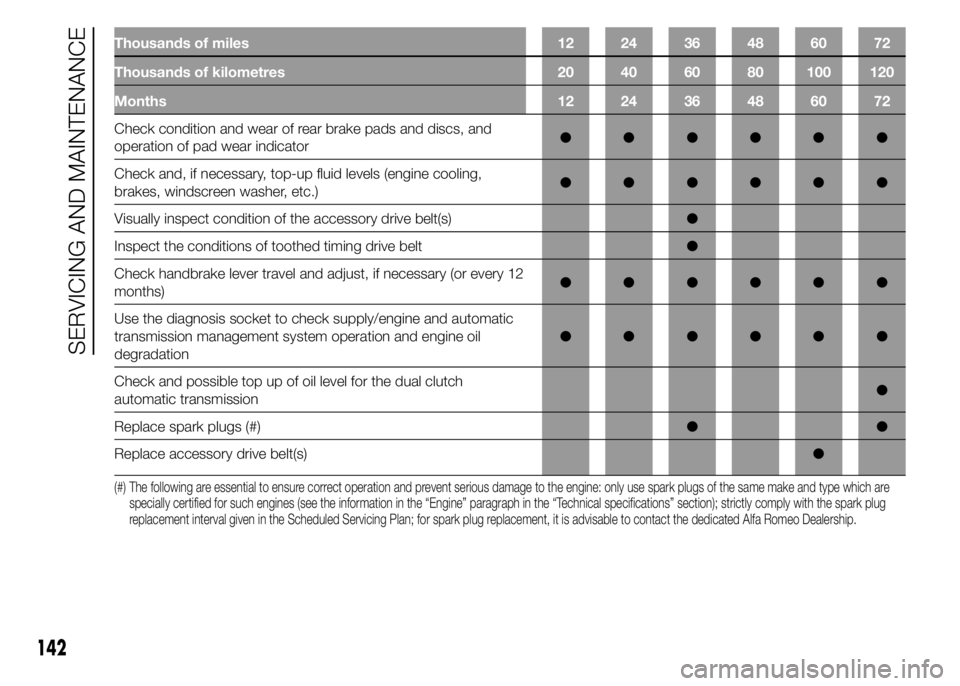
Thousands of miles 12 24 36 48 60 72
Thousands of kilometres 20 40 60 80 100 120
Months 12 24 36 48 60 72
Check condition and wear of rear brake pads and discs, and
operation of pad wear indicator●●●●●●
Check and, if necessary, top-up fluid levels (engine cooling,
brakes, windscreen washer, etc.)●●●●●●
Visually inspect condition of the accessory drive belt(s)●
Inspect the conditions of toothed timing drive belt●
Check handbrake lever travel and adjust, if necessary (or every 12
months)●●●●●●
Use the diagnosis socket to check supply/engine and automatic
transmission management system operation and engine oil
degradation●●●●●●
Check and possible top up of oil level for the dual clutch
automatic transmission●
Replace spark plugs (#)●●
Replace accessory drive belt(s)●
(#) The following are essential to ensure correct operation and prevent serious damage to the engine: only use spark plugs of the same make and type whichare
specially certified for such engines (see the information in the “Engine” paragraph in the “Technical specifications” section); strictly comply with the spark plug
replacement interval given in the Scheduled Servicing Plan; for spark plug replacement, it is advisable to contact the dedicated Alfa Romeo Dealership.
142
SERVICING AND MAINTENANCE
Page 147 of 199
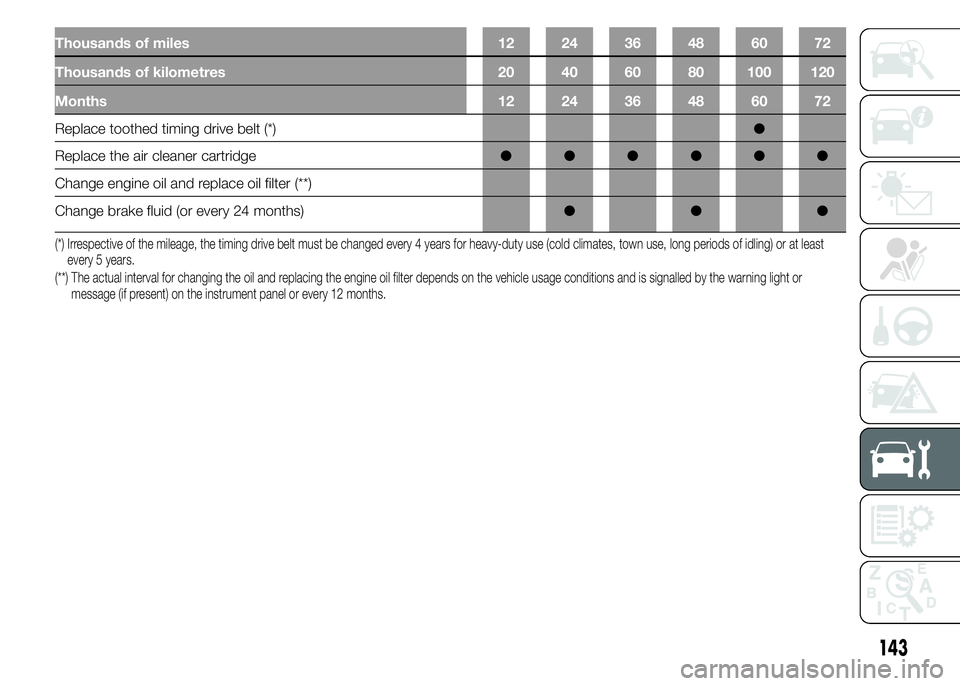
Thousands of miles 12 24 36 48 60 72
Thousands of kilometres 20 40 60 80 100 120
Months 12 24 36 48 60 72
Replace toothed timing drive belt (*)●
Replace the air cleaner cartridge●●●●●●
Change engine oil and replace oil filter (**)
Change brake fluid (or every 24 months)●●●
(*) Irrespective of the mileage, the timing drive belt must be changed every 4 years for heavy-duty use (cold climates, town use, long periods of idling) or at least
every 5 years.
(**) The actual interval for changing the oil and replacing the engine oil filter depends on the vehicle usage conditions and is signalled by the warning light or
message (if present) on the instrument panel or every 12 months.
143
Page 148 of 199
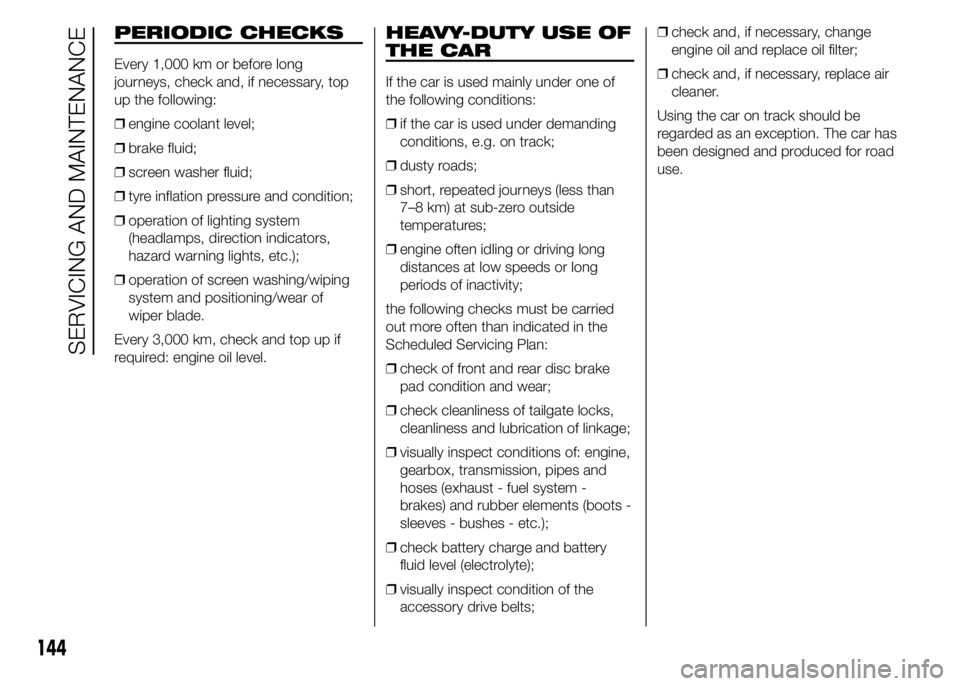
PERIODIC CHECKS
Every 1,000 km or before long
journeys, check and, if necessary, top
up the following:
❒engine coolant level;
❒brake fluid;
❒screen washer fluid;
❒tyre inflation pressure and condition;
❒operation of lighting system
(headlamps, direction indicators,
hazard warning lights, etc.);
❒operation of screen washing/wiping
system and positioning/wear of
wiper blade.
Every 3,000 km, check and top up if
required: engine oil level.
HEAVY-DUTY USE OF
THE CAR
If the car is used mainly under one of
the following conditions:
❒if the car is used under demanding
conditions, e.g. on track;
❒dusty roads;
❒short, repeated journeys (less than
7–8 km) at sub-zero outside
temperatures;
❒engine often idling or driving long
distances at low speeds or long
periods of inactivity;
the following checks must be carried
out more often than indicated in the
Scheduled Servicing Plan:
❒check of front and rear disc brake
pad condition and wear;
❒check cleanliness of tailgate locks,
cleanliness and lubrication of linkage;
❒visually inspect conditions of: engine,
gearbox, transmission, pipes and
hoses (exhaust - fuel system -
brakes) and rubber elements (boots -
sleeves - bushes - etc.);
❒check battery charge and battery
fluid level (electrolyte);
❒visually inspect condition of the
accessory drive belts;❒check and, if necessary, change
engine oil and replace oil filter;
❒check and, if necessary, replace air
cleaner.
Using the car on track should be
regarded as an exception. The car has
been designed and produced for road
use.
144
SERVICING AND MAINTENANCE
Page 149 of 199

CHECKING LEVELS.
The topping-up plug B and the dipstick A for checking the engine oil level and the reservoir C for the engine coolant can be
accessed by lifting the tailgate (see the procedure in the "Engine cover/Luggage Compartment" paragraph in the "Knowing
your car" chapter).
21)
118) 119) 120)
119A0L0152
145
Page 150 of 199
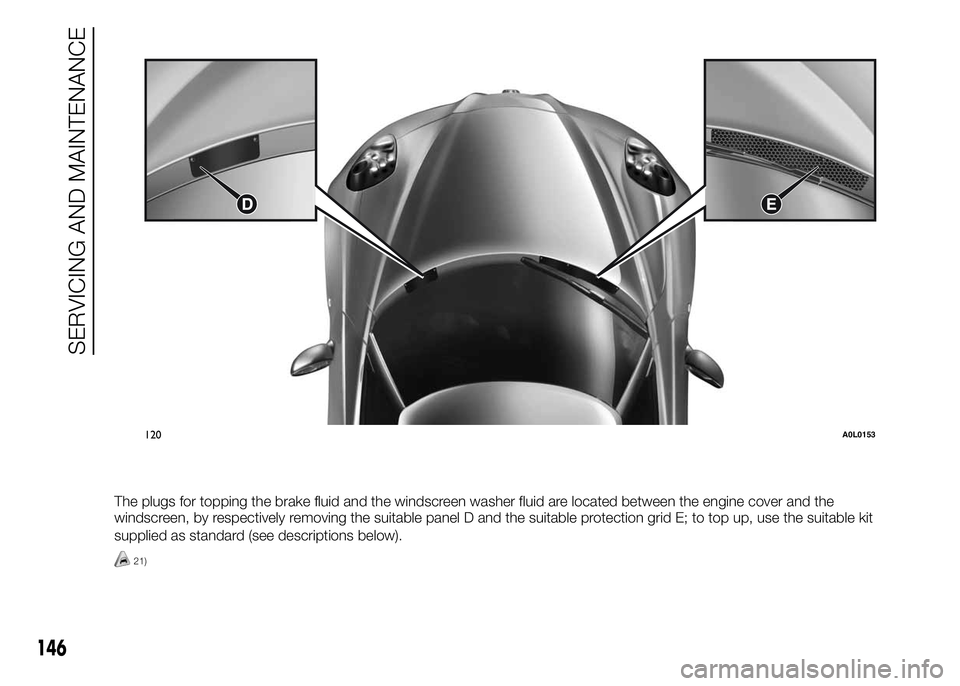
The plugs for topping the brake fluid and the windscreen washer fluid are located between the engine cover and the
windscreen, by respectively removing the suitable panel D and the suitable protection grid E; to top up, use the suitable kit
supplied as standard (see descriptions below).
21)
120A0L0153
146
SERVICING AND MAINTENANCE
Page 151 of 199
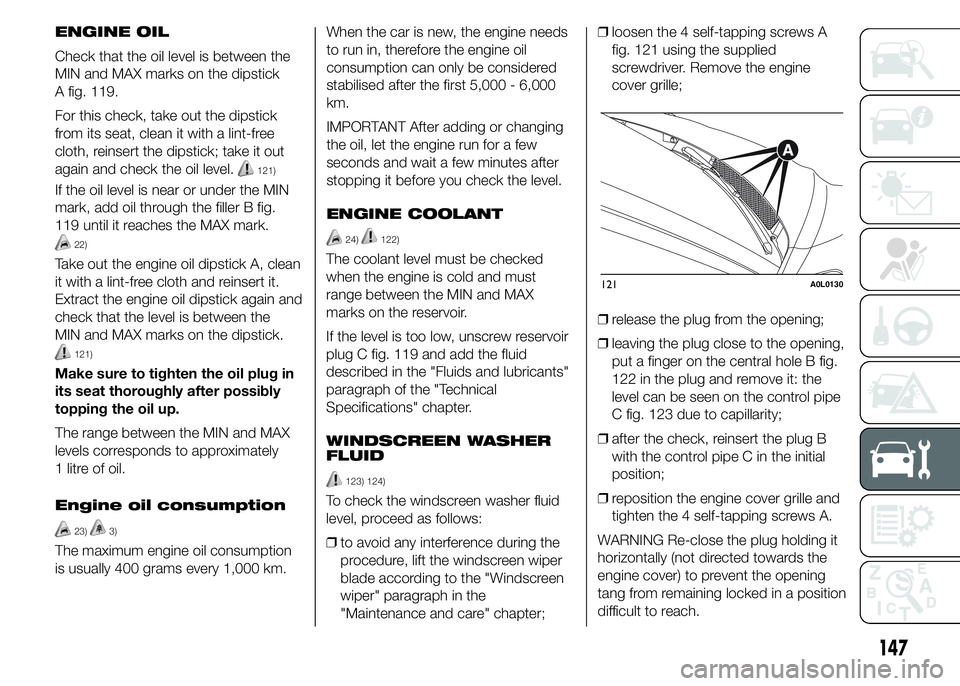
ENGINE OIL
Check that the oil level is between the
MIN and MAX marks on the dipstick
A fig. 119.
For this check, take out the dipstick
from its seat, clean it with a lint-free
cloth, reinsert the dipstick; take it out
again and check the oil level.
121)
If the oil level is near or under the MIN
mark, add oil through the filler B fig.
119 until it reaches the MAX mark.
22)
Take out the engine oil dipstick A, clean
it with a lint-free cloth and reinsert it.
Extract the engine oil dipstick again and
check that the level is between the
MIN and MAX marks on the dipstick.
121)
Make sure to tighten the oil plug in
its seat thoroughly after possibly
topping the oil up.
The range between the MIN and MAX
levels corresponds to approximately
1 litre of oil.
Engine oil consumption
23)3)
The maximum engine oil consumption
is usually 400 grams every 1,000 km.When the car is new, the engine needs
to run in, therefore the engine oil
consumption can only be considered
stabilised after the first 5,000 - 6,000
km.
IMPORTANT After adding or changing
the oil, let the engine run for a few
seconds and wait a few minutes after
stopping it before you check the level.
ENGINE COOLANT
24)122)
The coolant level must be checked
when the engine is cold and must
range between the MIN and MAX
marks on the reservoir.
If the level is too low, unscrew reservoir
plug C fig. 119 and add the fluid
described in the "Fluids and lubricants"
paragraph of the "Technical
Specifications" chapter.
WINDSCREEN WASHER
FLUID
123) 124)
To check the windscreen washer fluid
level, proceed as follows:
❒to avoid any interference during the
procedure, lift the windscreen wiper
blade according to the "Windscreen
wiper" paragraph in the
"Maintenance and care" chapter;❒loosen the 4 self-tapping screws A
fig. 121 using the supplied
screwdriver. Remove the engine
cover grille;
❒release the plug from the opening;
❒leaving the plug close to the opening,
put a finger on the central hole B fig.
122 in the plug and remove it: the
level can be seen on the control pipe
C fig. 123 due to capillarity;
❒after the check, reinsert the plug B
with the control pipe C in the initial
position;
❒reposition the engine cover grille and
tighten the 4 self-tapping screws A.
WARNING Re-close the plug holding it
horizontally (not directed towards the
engine cover) to prevent the opening
tang from remaining locked in a position
difficult to reach.
121A0L0130
147
Page 152 of 199
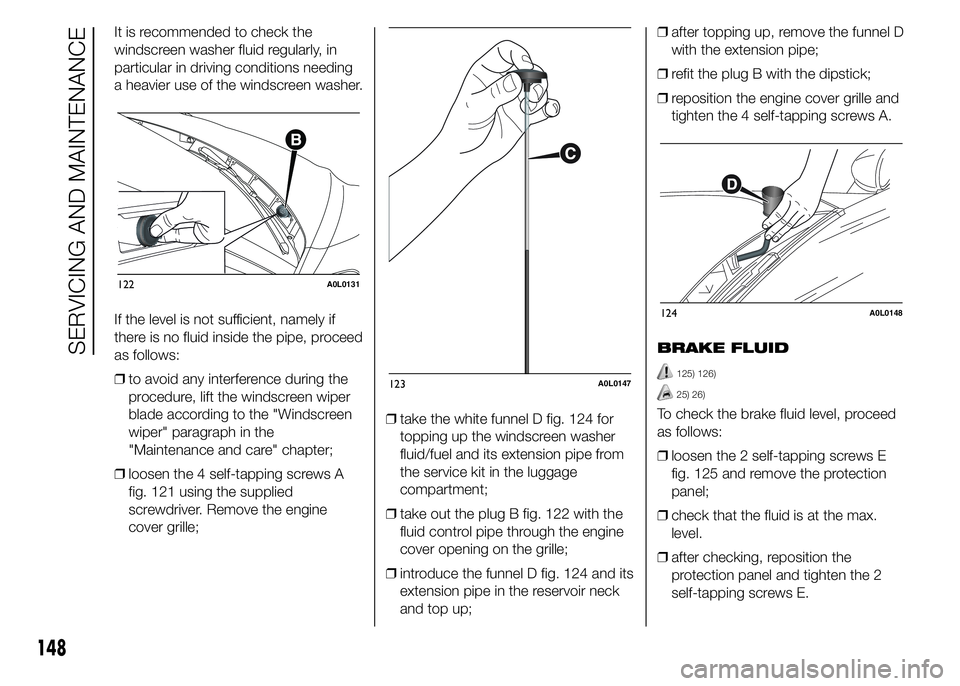
It is recommended to check the
windscreen washer fluid regularly, in
particular in driving conditions needing
a heavier use of the windscreen washer.
If the level is not sufficient, namely if
there is no fluid inside the pipe, proceed
as follows:
❒to avoid any interference during the
procedure, lift the windscreen wiper
blade according to the "Windscreen
wiper" paragraph in the
"Maintenance and care" chapter;
❒loosen the 4 self-tapping screws A
fig. 121 using the supplied
screwdriver. Remove the engine
cover grille;❒take the white funnel D fig. 124 for
topping up the windscreen washer
fluid/fuel and its extension pipe from
the service kit in the luggage
compartment;
❒take out the plug B fig. 122 with the
fluid control pipe through the engine
cover opening on the grille;
❒introduce the funnel D fig. 124 and its
extension pipe in the reservoir neck
and top up;❒after topping up, remove the funnel D
with the extension pipe;
❒refit the plug B with the dipstick;
❒reposition the engine cover grille and
tighten the 4 self-tapping screws A.
BRAKE FLUID
125) 126)
25) 26)
To check the brake fluid level, proceed
as follows:
❒loosen the 2 self-tapping screws E
fig. 125 and remove the protection
panel;
❒check that the fluid is at the max.
level.
❒after checking, reposition the
protection panel and tighten the 2
self-tapping screws E.
122A0L0131
123A0L0147
124A0L0148
148
SERVICING AND MAINTENANCE
Page 153 of 199
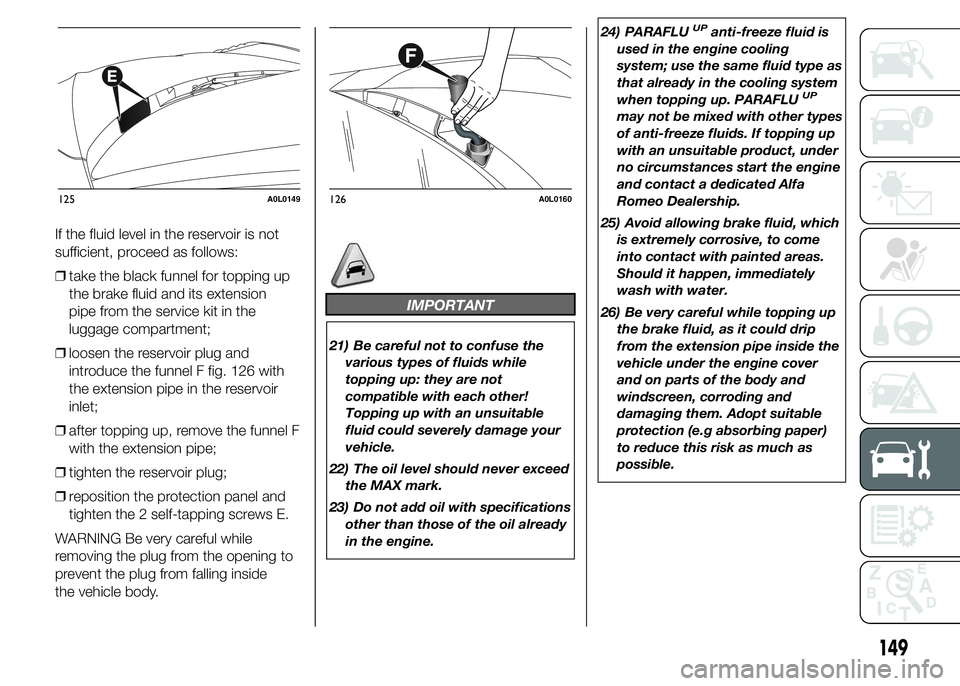
If the fluid level in the reservoir is not
sufficient, proceed as follows:
❒take the black funnel for topping up
the brake fluid and its extension
pipe from the service kit in the
luggage compartment;
❒loosen the reservoir plug and
introduce the funnel F fig. 126 with
the extension pipe in the reservoir
inlet;
❒after topping up, remove the funnel F
with the extension pipe;
❒tighten the reservoir plug;
❒reposition the protection panel and
tighten the 2 self-tapping screws E.
WARNING Be very careful while
removing the plug from the opening to
prevent the plug from falling inside
the vehicle body.
IMPORTANT
21) Be careful not to confuse the
various types of fluids while
topping up: they are not
compatible with each other!
Topping up with an unsuitable
fluid could severely damage your
vehicle.
22) The oil level should never exceed
the MAX mark.
23) Do not add oil with specifications
other than those of the oil already
in the engine.24) PARAFLU
UPanti-freeze fluid is
used in the engine cooling
system; use the same fluid type as
that already in the cooling system
when topping up. PARAFLU
UP
may not be mixed with other types
of anti-freeze fluids. If topping up
with an unsuitable product, under
no circumstances start the engine
and contact a dedicated Alfa
Romeo Dealership.
25) Avoid allowing brake fluid, which
is extremely corrosive, to come
into contact with painted areas.
Should it happen, immediately
wash with water.
26) Be very careful while topping up
the brake fluid, as it could drip
from the extension pipe inside the
vehicle under the engine cover
and on parts of the body and
windscreen, corroding and
damaging them. Adopt suitable
protection (e.g absorbing paper)
to reduce this risk as much as
possible.
125A0L0149126A0L0160
149